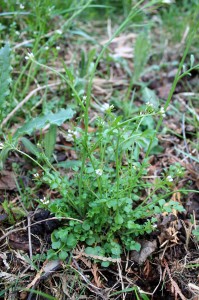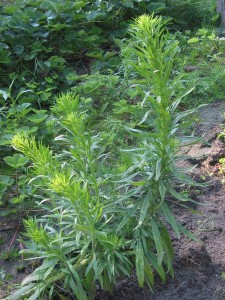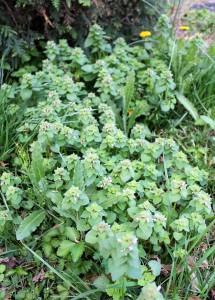Weeds Off to a Happy Start
April 12th, 2012
A weed couldn’t ask for better weather than we’ve had so far this year.
The same extraordinarily warm start that had our dogwoods blooming three weeks early has been a boon to weeds as well — especially ones that sprout from seed in late winter to early spring.
So-called “winter annual weeds” such as purple deadnettle, chickweed, creeping veronica and a relative rookie invader known as hairy bittersweet have been rampant in lawns and garden beds everywhere.
“We’ve got two things going on,” explains Dr. William Curran, a weed specialist with Penn State Extension in State College. “One is the mild weather. Everything came alive two or more weeks earlier this year.
“Why weeds are more prevalent is harder to answer. It could be the series of warm winters has caused a slow buildup, and now we’re exploding with weeds. Or it could be that winters are not killing off things that normally would die in the cold.”
Curran says he’s seen a gradual northward creep of weeds that we didn’t even used to have.
A classic example: kudzu, the “vine that ate the South.”
“We’ve had kudzu in Pennsylvania for years, but we never thought of it as something that would flower and set seed in Pennsylvania,” says Curran. “It does now.”
Weeds that spread by seed spread much farther much faster than weeds that spread mainly by creeping.
Mare’s tail (a.k.a. “horseweed”) is another weed that’s new trouble here. This tall pest with the skinny leaves and wispy yellow flowers once was mainly a Philadelphia-area problem but has expanded its range.
And our worst relative newcomer has been hairy bittercress, a ground-hugger that starts out as a patch of tiny rounded leaves but soon sends up foot-tall wiry shoots with tiny white flowers at the tip.
But even our old not-so-favorites are having a banner season so far.
Creeping speedwell and chickweed got off to an early start and flourished because of the lack of snowcover to block sunlight, plus warm soil to fuel its roots.
Speedwell is the low creeper that blooms blue, while chickweed has similar clusters of small leaves but blooms white.
Henbit and purple deadnettle are two others off to a great start, both in low-attention lawns and unmulched garden beds.
Often confused because they look so similar, both are winter annuals that send up mint-like square stems and produce light lavender flowers.
Home gardeners aren’t so much concerned with what’s what as how to keep weeds from overtaking the landscape.
For weeds that are already up, “you’re looking at removing them by hand or by hoe, or by using some type of foliage herbicide,” says Curran.
Annual weeds usually come up easily since they’ve only had a few weeks to grow since emerging from seed.
Perennial weeds are tougher because they’re returning from roots. These usually require some sort of mechanical loosening (weeding knife, screwdriver, etc.) to lift out all of the roots.
A kill-most-everything-green product such as glyphosate (the ingredient in Roundup) is an option in garden beds, while a broad-leaf weed-killer is an option in lawns.
Just don’t let glyphosate spray drift onto the leaves of plants you don’t want to kill.
In the lawn, Curran says spot-sprays of liquid broad-leaf weed-killer (Ortho’s Weed B Gon is the best-known example) are more effective than granular “weed and feed” spread over the whole lawn.
After dispatching what’s already up, kick into prevention mode.
Crabgrass, for example, is just starting to germinate.
It’s not too late to put crabgrass-preventing products on the lawn. Do it soon, though, if you’ve had a problem with this grassy weed in the past and want to keep it from getting out of control by summer.
Ditto with landscape-bed weed-preventers, such as Preen or corn gluten meal. While these granular weed preventers won’t stop already-germinated winter annuals or perennial weeds returning from roots, they can stop weeds yet to germinate from seeds.
That includes the champion of mid-spring weeds, the dandelion, as well as summer weeds, such as pigweed, purslane, ragweed and lamb’s quarter.
Then there’s mulch. Now’s a good time to cover any bare soil with a total of 2 to 3 inches of organic mulch (bark chips, leaves, shredded wood, etc.) to smother weed seeds in the soil.
Keeping that “seed bank” under control is critical to long-term victory over weeds, says Dr. Robert Norris, a retired professor of plant sciences at the University of California at Davis.
Norris once did research that found that a single chickweed plant could produce 25,000 seeds, while purslane could produce a staggering 2 million seeds per plant.
His suggestion: mulch to keep new weeds from coming up and hoe or pull every weed before it flowers and seeds.
“Diligence is the key,” he says. “Never let one weed go to seed or you will be back to square one.”
Keep pulling and keep new seeds out (most drop near the parent plant instead of blowing in), Norris says, and you’ll bankrupt the weed-seed bank in an average of 5 years.
You might never end up totally weed-free, but a drastic reduction still would be nice.
Especially right now.










